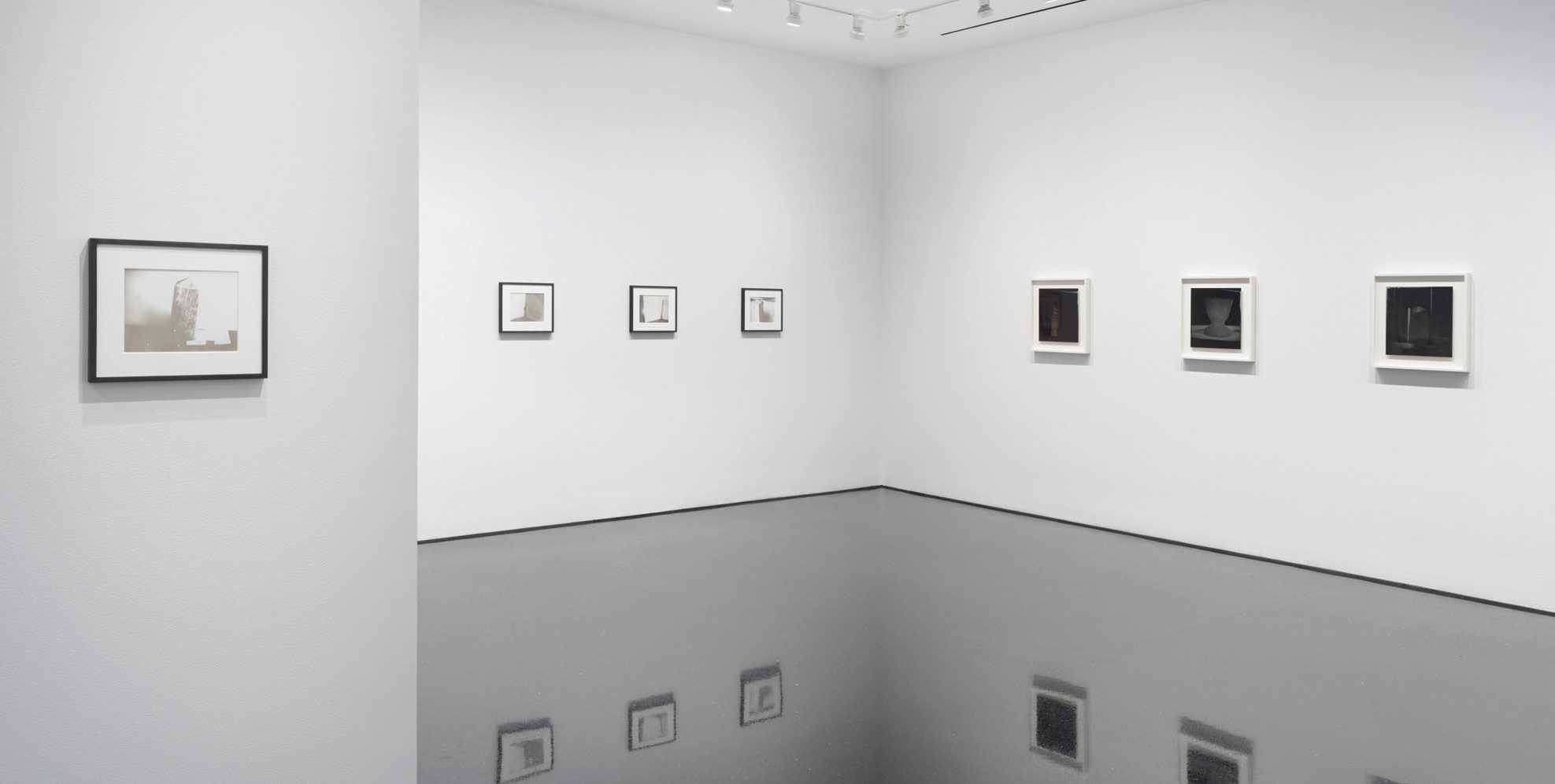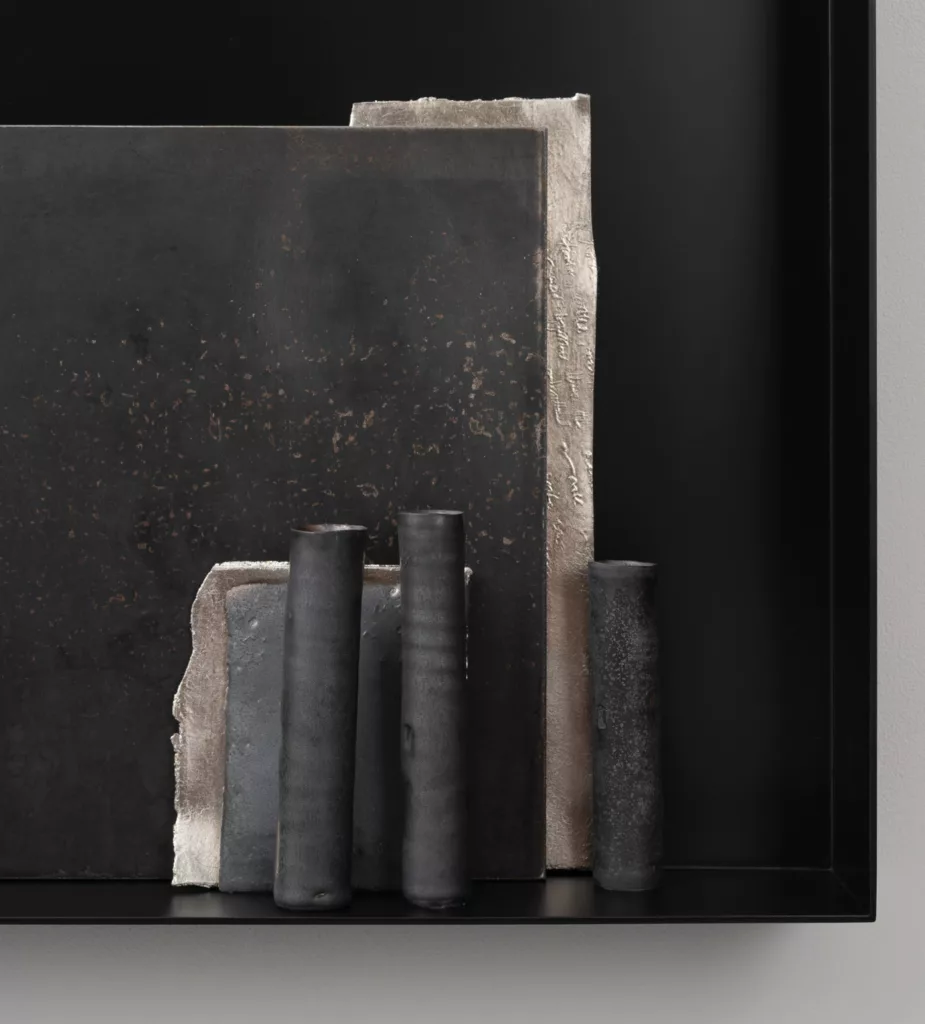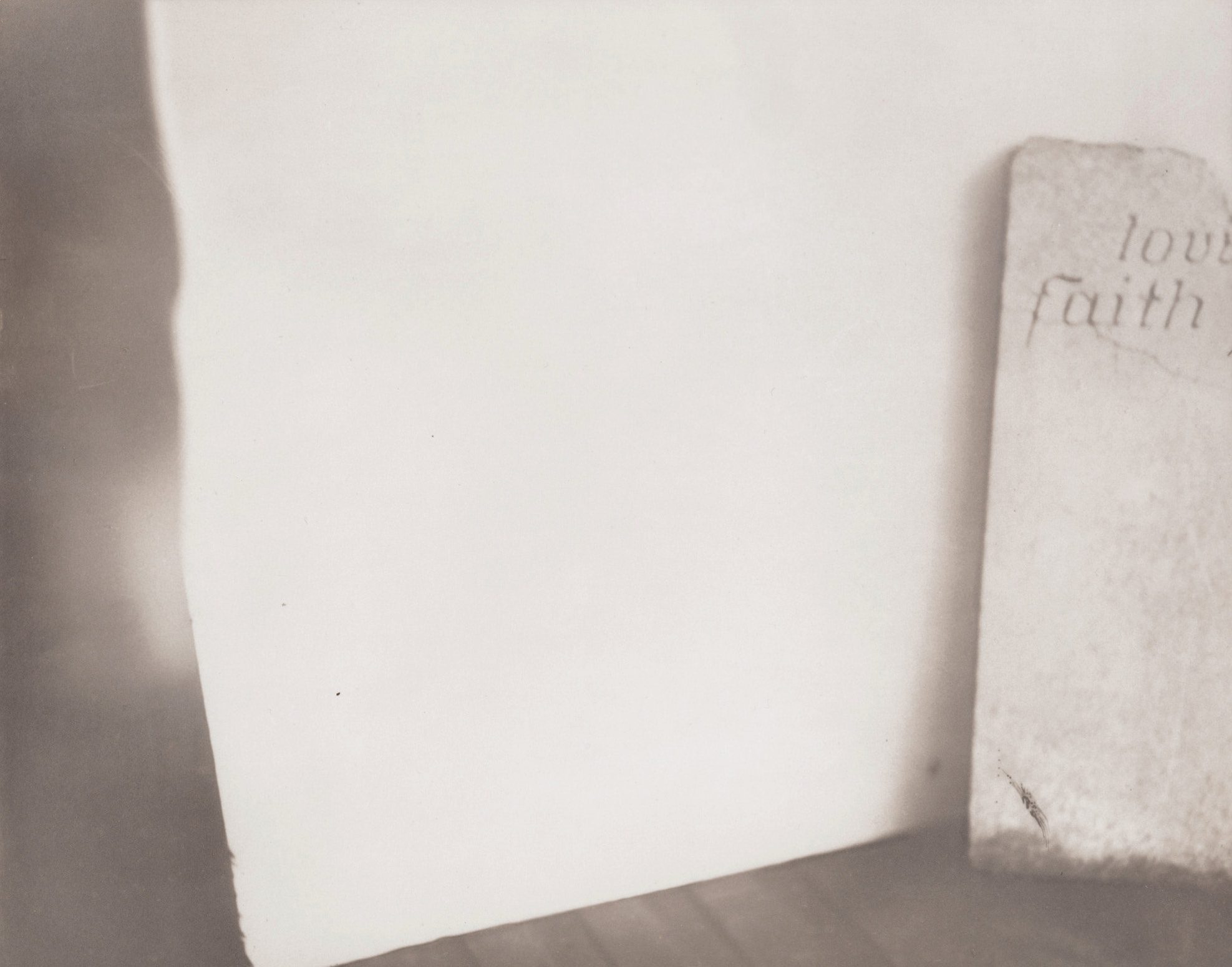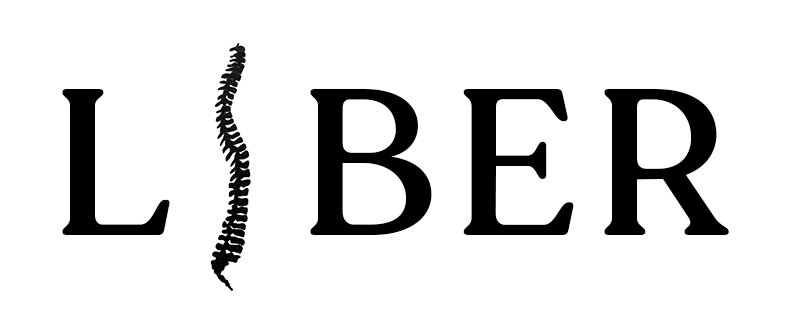
In a storied career spanning nearly fifty years, the photographer Sally Mann has known no shortage of either acclaim or controversy. Her latest exhibit at Gagosian, to light, and then return—, shows work as new, serious, and beautiful as anything she ever has made, but it seems to have escaped much attention. The title, a line from Emily Dickinson, suggests an interstitial space between two states, a useful prompt for how to view this work, so often depicting a world between life and death. Mann’s images, largely of well-worn tools, abandoned buildings, and historic gravestones, occupy two spartan rooms interspersed with compact white and black porcelain arrangements by the British potter Edmund de Waal. (The latter had a concurrent exhibition of his own at the downtown Gagosian.) Despite their smallness and beauty, de Waal’s pieces manage to suggest the industrial scale of twentieth-century atrocities. The effect for a viewer taking in the work of these two very different artists is to ricochet between the quotidian and the epic, the expected losses in life, however haunting, and those so vast as to remain incomprehensible. In a dialogue with de Waal that is included in the catalog, Mann remarks that photography is “an elegiac art . . . It’s a memento mori—always filled with pathos.” The collaboration between these two artists suggests at every juncture Virgil’s “tears in things,” but strangely, and unusually for Mann, there is little drama in this work, only a sense of the ordinary manifestations of grief and their relentless persistence.
The two artists first met on the page, when the painter Cy Twombly, a lifelong family friend of Mann’s, suggested she read de Waal’s memoir, The Hare with the Amber Eyes (2010). After getting to know each other’s work, they held a dialogue at the Frick in 2019. In person, they described at length their idiosyncratic processes. Mann was fierce, warm, and self-doubting, while de Waal was fizzy and gentle, but ever searching as he probed their mutualities and differences in a conversation which led eventually to this exhibit. If elegy animates both artists, it is nonetheless apparent in this work that neither nostalgia nor sentimentality nor lament is their intent.

Alchemy, both chemical and spiritual, is Mann’s method. In this exhibit she uses collodion on aluminum to produce images of farm tools and implements that have the eerie quality of appearing far sharper at a distance than they do up close. These are still lifes, as she titles them, but her arrangements of implements often suggest eternal movement, as if labor can never cease. The viewer senses a care similar to de Waal’s in arranging the inanimate, making the spaces between things resonate more than the things themselves. In Tintype, Still Life #35, a few simple objects, perhaps tools but not easily identified, assume a heft and rootedness that can only be discerned by the swirl of fog wafting through them. Similarly, her platinum prints of gravestones have a gradation and depth of tone that suggest life in a world beyond ours. Mann uses box cameras, antique lenses, and a method that invites imperfection through dust and uneven coating. In image after image, her laborious techniques evoke the intemporal.
The austerity of Mann’s work here—its taciturnity, even—is in intricate counterpoint with de Waal’s small, intimate installations of porcelain, a material used more often in decorative tableware or false teeth than art. Composed often of tall, spindly vessels anchored by slabs, occasionally edged with precious metals, sometimes scrawled with often illegible scraps of poems, and contained within both wall-mounted and freestanding glass vitrines, de Waal’s work evokes the eternal life of mass destruction. If his vessels in black suggest the smokestacks of the death camps during the Shoah, then his vessels in white reaffirm the worth of each life taken. Throughout the exhibit, de Waal offers solid chords to Mann’s riffs, three dimensions to her two, a sense of monument to her images of worn and faded remnants.
De Waal’s vessels, often displayed in multiples but each incandescent and unique, have always suggested the dead, not as an entity but as a collective of individuals. It would be untrue to the nature of his work to suggest too neat a historical narrative, but de Waal is an intellectual and artistic heir of the Ephrussi family, Jewish and originally of Odessa, who parlayed a grain-trading business into an international oil and banking empire. Despite their wealth, influence, and loyalty to their respective nations, they lost many members, their fortune, and their social position in Vienna and Paris during the Shoah. Raised as an Anglican in England, de Waal has spent his life assembling the story of all that his family gained and lost in two massively researched but shapely memoirs, The Hare with the Amber Eyes and Letters to Camondo. It detracts nothing from either of his practices to say he is as much a writer as he is an artist.
The same can be said of Mann, who wrote a lively and equally searching history of her family, Hold Still (2015). As in her photographs, she has an eye for the bizarre, the beautiful, the wounded. What seems a casual cascade of anecdotes is actually a highly self-aware American story: the fortune amassed and dissipated on her Southern father’s side, the precarious upbringing on her Massachusetts mother’s side, where the family was supported by Mann’s grandmother’s wealthy lover. Complicated, too, were Mann’s doctor father, an artist at heart, and her Boston-proper mother, who had studied medicine before her vocation was sidelined by marriage. Hold Still is foremost, though, Mann’s own story. As an upper-middle-class white child, Mann felt that her family’s housekeeper, a black woman named Virginia Carter, rescued her from emotional neglect. But as Mann came to realize later in life, her loving and responsible primary caretaker earned only subsistence wages (and that despite Mann’s parents paying $5 more than the going rate) in the economically feudal and racially segregated world of 1950s Lexington, Virginia.
When Mann was sent off to the Putney School in Vermont at sixteen, she had to ask her history teacher what a Jew was. Her parents were exceptionally educated—and her mother was involved in progressive causes and eventually managed a university bookstore—but Mann was left to claw her own way out of a peculiarly American kind of ignorance. De Waal, too, despite having a much more systematic education, had to find his own way to his family’s tragic history through its elder members as well as through ceaseless exploration of their extensive archives and remaining objects. If, as the poet Czesław Miłosz once said, “When a writer is born into a family, the family is finished,” we might add that the writer’s family also has the chance to be reborn, as well as remembered, once its obscuring myths are swept away.

Finishing the family was how Sally Mann’s career took off with her 1992 exhibition Immediate Family. Or so her critics said. Her lush black-and-white photographs focused on her three children at liberty on their family farm, occasionally unclothed, playing, exulting, sulking, fighting, and staging their dramas, sometimes at their mother’s prompting. Following in the American tradition of Dorothea Lange or Walker Evans, these photographs depicted childhood as a fierce battle that children were destined to lose. Mann’s artistry was often seen as beyond the point or pale. It was one thing to photograph a street urchin, as did Lange, or a sharecropper’s child, as did Evans, but to suggest that ordinary middle-class childhood might be as stark a drama as any blood-soaked Greek tragedy was something worse than bad manners. Critics, many of them self-consciously feminist in orientation, accused Mann of “sexualizing” her children; one generally tolerant novelist said Mann’s children looked mean. The Wall Street Journal published a review with a photograph of Mann’s six-year-old child, her eyes, chest, and genitals blacked out, an act of perversity that says it all.
The children grew up and ceased to be subjects, and Sally Mann moved on. Her eye, though, naturally lit on the body, even when she was photographing now lush and deserted Civil War battlefields, the landscape’s voluptuous curves once dotted with the innumerable dead. Nearly always, she sees what we collude to make unseen. Especially disconcerting are her photos of decaying corpses housed outdoors at a “body farm” run to study the rate of decomposition. Having gone to the body farm on assignment for the New York Times in 2001, Mann then struggled to exhibit this work. (Eventually, it was shown at the Corcoran.) Her description of this experience in Hold Still is as unsettling as the images themselves: “One thing about the helpless dead struck me right away: you want to fix them up, to press the sagging lips together, close the indiscreet legs, wipe the dripping butt, shutter the liquefying eyes.”
A subsequent series, Men (2006–15), took as its subject young black men, the men who often were invisible to Mann as she grew up in a highly segregated world. The models were drawn from her community, their bodies often depicted as vulnerable or wounded, as if the history of the region had run them over like a truck. Mann risked melodrama with these anguished, heightened images. But they again remind us that, though we can’t change history or comfort its victims or repair the dead, we can bear witness.
Her current exhibit confronts us with the inadequacy of our methods: the tools and talismans we save, the gravestones we erect, the haunted houses we drift through. In abjuring both the human body and the land as subjects, though, Mann’s work here is constrained. Despite her tremendous gift for composition, the level of abstraction in this exhibit can seem a form of dissociation. Her greatest work reminds us that the self is housed in a human body, subject to the ravages of time and ultimately to annihilation. Her imagination lives in that friction between body and place, body and time.
Her images of the detritus of human life—tools, household objects, buildings, gravestones—lack a sense of the particular, the individual. They are our generic hauntings, inducing melancholy but no specific grief. It is probably not surprising that these pieces are titled either Still Life or Stone, depending on the medium. But what has made Mann’s work spellbinding—and provocative—through the years is the collision of the image with a protean but distinct narrative, never reductive and always animating, which she has somehow conjured out of paper or metal, light, and ether. The swollen face of a child, the wasting body of a once powerful man, the misshapen feet of a woman who has given a life of constant service: each suggests a particular story, however we might fill in the details.
It would not be fair to accuse Sally Mann of good taste at this late date in her career, but certainly no image included here has the power to disturb in the way of her earlier work. Perhaps there is an accommodation here to time itself, to the work of another artist, to the hyper-politicization of this period. If we see this work as a pause, a meditative moment, though, we can follow its lead and let these images settle, perhaps to haunt us, perhaps to comfort us, perhaps to encourage us to appreciate what truly remains.

